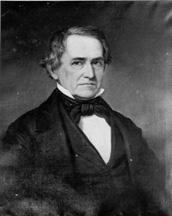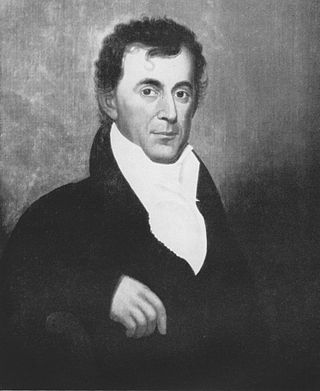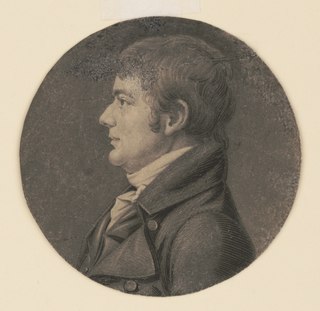
The 27th United States Congress was a meeting of the legislative branch of the United States federal government, consisting of the United States Senate and the United States House of Representatives. It met in Washington, D.C., between March 4, 1841, and March 4, 1843, during the one-month presidency of William Henry Harrison and the first two years of the presidency of his successor, John Tyler. The apportionment of seats in the House of Representatives was based on the 1830 United States census. Both chambers had a Whig majority.

William Bradley Umstead was an American politician who served as a United States Senator and the 63rd governor of North Carolina from 1953 to 1954.

Willie Person Mangum was an American politician and planter who served as U.S. Senator from the state of North Carolina between 1831 and 1836 and between 1840 and 1853. He was one of the founders and leading members of the Whig party, and was a candidate for president in 1836 as part of the unsuccessful Whig strategy to defeat Martin Van Buren by running four candidates with local appeal in different regions of the country.

Robert Strange was a Democratic U.S. senator from the state of North Carolina between 1836 and 1840.

Littleton Waller Tazewell was a Virginia lawyer, plantation owner, and politician who served as U.S. Representative, U.S. Senator and the 26th Governor of Virginia, as well as a member of the Virginia House of Delegates.

John Wayles Eppes was an American lawyer and politician. He represented Virginia in the U.S. House of Representatives from 1803 to 1811 and again from 1813 to 1815. He also served in the U.S. Senate (1817–1819). His positions in Congress occurred after he served in the Virginia House of Delegates representing Chesterfield County (1801–1803).
A plantation house is the main house of a plantation, often a substantial farmhouse, which often serves as a symbol for the plantation as a whole. Plantation houses in the Southern United States and in other areas are known as quite grand and expensive architectural works today, though most were more utilitarian, working farmhouses.
John Chavis was a free Black educator and Presbyterian minister in the American South during the early 19th century. Born in Oxford, North Carolina, he fought for the Continental Army during the American Revolutionary War. He was the first African American known to attend college in the U.S., though it is not clear if he graduated. He studied with John Witherspoon at the College of New Jersey and finished his studies at Liberty Hall Academy in Virginia, where he was licensed to preach. Later, while working in Raleigh, North Carolina, he established a private school that was highly regarded and attended by both white and Black students.
Peterson Goodwyn was an American planter, lawyer, soldier and politician from Virginia. He served in the United States House of Representatives from 1803 until his death in 1818.

Bahama is an unincorporated community in northern Durham County, North Carolina, United States.

Rosedown Plantation State Historic Site is an 8,000-square-foot (740 m2) historic home and former plantation located in St. Francisville, Louisiana, United States. Built in 1835 by Daniel and Martha Turnbull, it is one of the most documented and intact plantation complexes in the Southern United States. It is known for its extensive formal gardens surrounding the house.

Millford Plantation is a historic farmstead and plantation house located on SC 261 west of Pinewood, South Carolina. It was sometimes called Manning's Folly, because of its remote location in the High Hills of Santee section of the state and its elaborate details. Designated as a National Historic Landmark, it is regarded as one of the finest examples of Greek Revival residential architecture in the United States. The house has been restored and preserved along with many of its original Duncan Phyfe furnishings.

Tuckahoe, also known as Tuckahoe Plantation, or Historic Tuckahoe is located in Tuckahoe, Virginia on Route 650 near Manakin Sabot, Virginia, overlapping both Goochland and Henrico counties, six miles from the town of the same name. Built in the first half of the 18th century, it is a well-preserved example of a colonial plantation house, and is particularly distinctive as a colonial prodigy house. Thomas Jefferson is also recorded as having spent some of his childhood here. It was declared a National Historic Landmark in 1969.

Plantation complexes were common on agricultural plantations in the Southern United States from the 17th into the 20th century. The complex included everything from the main residence down to the pens for livestock. Until the abolition of slavery, such plantations were generally self-sufficient settlements that relied on the forced labor of enslaved people.
Hugh Mangum was an American photographer who worked in the American South from the 1890s through 1922 at the height of Jim Crow laws mandating racial segregation and discrimination. Like a few other photographers in the South at the time, Mangum seemed to have maintained an open door policy in his itinerant and studios, and welcomed blacks and whites alike. His glass plate negatives, found in a family barn slated for demolition, were brought to light almost fifty years after his death.

Slavery was legally practiced in the Province of North Carolina and the state of North Carolina until January 1, 1863, when President Abraham Lincoln issued the Emancipation Proclamation. Prior to statehood, there were 41,000 enslaved African-Americans in the Province of North Carolina in 1767. By 1860, the number of slaves in the state of North Carolina was 331,059, about one third of the total population of the state. In 1860, there were nineteen counties in North Carolina where the number of slaves was larger than the free white population. During the antebellum period the state of North Carolina passed several laws to protect the rights of slave owners while disenfranchising the rights of slaves. There was a constant fear amongst white slave owners in North Carolina of slave revolts from the time of the American Revolution. Despite their circumstances, some North Carolina slaves and freed slaves distinguished themselves as artisans, soldiers during the Revolution, religious leaders, and writers.

Lipscomb House, or Lipscombe House, is a historic Federal-style plantation house in Durham, North Carolina, United States. The Lipscomb Plantation, sitting on 2,000 acres between the Eno River and the Little River, was one of the largest forced-labor cotton farms in Durham County. The plantation was part of the Trading Path, used by Catawba and Waxhaw Native American tribes trading between Petersburg, Virginia, and Hillsborough, North Carolina. The house is now run as a bed and breakfast.
William Tucker was born to two of the first Africans in Virginia who landed in Jamestown Colony before his birth. He was the first African American that was born in the British colonies that later became the United States.














